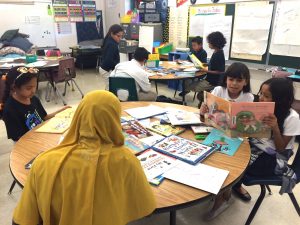By Yoo Kyung Sung, University of New Mexico and Junko Sakoi, Tucson Unified School District
In the last decade, Arizona consistently ranks among the top ten states with the number of refugee arrivals (Refugee Processing Center, 2018) with more than 15,400 refugees resettled in Arizona from 2012 through 2016. Accordingly, Tucson Unified School District (TUSD) received refugees since the late 1970s from the Southeast Asian countries, Russia, Iraq, Afghanistan, Cuba, Somalia and Sudan. Democratic Republic of the Congo and Burundi refugees have been the largest groups to arrive in Tucson in 2018 (Arizona Refugee Resettlement Program, 2018), in addition to fifty other countries with thirty-eight different languages. In the past five years, TUSD yearly enrollment has averaged around 900 refugee students across K-12 schools (Tucson Unified School District, 2018).
Our conversation about how refugee students fare in TUSD started with a few simple questions about what they think of their life in Tucson. We studied these questions to see how we can support, not only refugee students, but also children in Tucson who may have limited knowledge of refugees. Specifically:
1) How do they continue to be connected with their heritage, languages, cultures and customs?
2) How Tucsonan students understand refugee students in their home community?
3) What would be a shared experience that acts as a bridge between refugee children and non-refugee ones?
These questions led us to create a project we call, “Read, Write, Review for Us (RWRU)” that may help bridge the experiences of Tucsonan children with those of the NEW Tucsonan students (refugee and immigrant children) via children’s literature and various writing activities. We invited teachers and students from two classrooms in two different schools in TUSD to participate.
Students to Students and School to School
The first group was a 5th grade ELD class at an elementary school in central Tucson which boasts one of the most diverse school populations in the district. The class included one Syrian, one Iraqi, one Somali, one Ethiopian, one Marshallese, one Nepal and five Mexicans. The second group was a 3rd grade classroom in a different school located on the east side of Tucson with children predominantly from white middle-class families. The class included fifteen Caucasians, five Hispanics, one German and one Lithuanian.
Read, Write, Review for Us
At the beginning of the new school year, the 5th-grade refugee and immigrant students sent their first letters to the 3rd grade students at the east side school. The 3rd graders composed their responses and sent a letter in return to the 5th graders. Meanwhile, RWRU reviewed global and international literature that the classrooms might find useful to help the students establish a sense of place. Because many of the children had such different backgrounds, the general idea was that these books would help to promote a conversation between them about their home countries, their culture and how those things cultivate a sense of personal attachment and belonging. In the weeks following, the students in both classrooms participated in global and international book browsing sessions. This led to the planned writing and art activities, where the 5th graders wrote mini book reviews and created bookmarks, which were exchanged with students from the other class.
In October WOW Currents, we are going to share how RRWU projects helped the 5th graders (the new Tucsonan children) create shared experiences with native Tucsonan children. The selected children’s books were characterized by the 5th graders as stories “about home.” After reading these books, RRWU found that the students’ responses nearly recovered their voice as readers and storytellers. Those voices will serve as a great resource to native Tucsonan children to help broaden their understanding of the 5th graders and what they have been through. Many of the 5th graders have crossed the national border(s) and are continuing their journey in their new home, Tucson Arizona.
References
Arizona Department of Economic Security. (2018). Arizona Refugee Resettlement Program. Retrieved from https://des.az.gov/services/aging-and-adult/refugee-resettlement/about-refugee-resettlement
Refugee Processing Center. (2018). Refugee arrivals by state and nationality. Retrieved from http://www.wrapsnet.org/admissions-and-arrivals/
Tucson Unified School District. (2018). Refugee services. Retrieved from http://www.tusd1.org/Departments/Refugee/Refugee-Services-Resources
National Partnership for New Americans (2018). Immigration policies. Retrieved from http://partnershipfornewamericans.org/america, September 22, 2018.
Journey through Worlds of Words during our open reading hours: Monday-Friday, 9 a.m. to 5 p.m. and Saturday, 9 a.m. to 1 p.m.
- Themes: Junko Sakoi, Refugee Waves and New Voices, Yoo Kyung Sung
- Descriptors: Student Connections, WOW Currents

